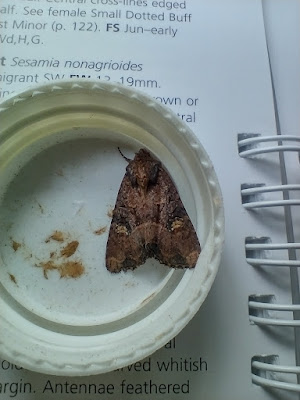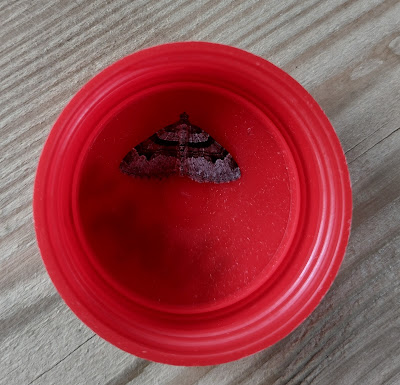As if Saturday's trip out to West Somerset and a wildflower field wasn't enough, at 8.30 am on Sunday I found myself driving the 8 miles or so to a friend of mine's garden in North Somerset, where, despite the rain and the wind the evening before, a moth trap had been set up the previous night.
Higgy (for he is a man of one name) had long been trying to organise a moth trapping event for the local conservation group YACWAG (Yatton And Congresbury Wildlife Action Group) of which he is a member. This planning had been going on for weeks, but with the recent run of wet and windy weekends all attempts to fire up the moth trap had been cancelled. However this weekend despite the weather forecast being at best 'iffy' Higgy informed me the trap would be lit and come-what-may it is going ahead so come to the garden at 9am when all will be revealed. I arrived at ten to 9 in the morning, the only person at that point.
Now, I have been to moth trapping set ups before but in every case I'd been there for work. Fascinating though they were at the time, I was there to record radio programmes so having to concentrate on that I always left having absolutely no idea what I'd seen. This then would be my very first participation moment for the reveal, and I wasn't disappointed, though as 9am came and went for a while I feared no one else would turn up.
Higgy's garden is a wildlife haven - the width of a 1960's house, the garden is long, and beyond the fence he also owns a slice of the field at the back. In fact this is where YACWAG are interesting, as not only are they an excellent conservation group who run events, provide advice and can undertake surveys, but YACWAG own parcels of land around the two villages in North Somerset and once in their ownership that land is managed solely for wildlife. That alone makes it a remarkable local conservation organisation.
Not only had the trap been set up the night before but Higgy had been up since first light emptying the trap and placing examples of the 283 individual moths caught that night into specimen tubes and arranging them for us to peer at. It was now well after 9am and I was still the only person and that made me feel sad for Higgy over the work and effort he'd put in, but eventually we swelled to a group of 4 other plus his daughter who was asked to be chief moth releaser, as all moths were released once identified. Enough people really otherwise it would become unwieldy, and as a group we set to flicking through the books and listening to Higgy's hints and tips while gazing manically at an as yet unidentified brown moth in a specimen tube.

Some I recognised immediately like this Jersey Tiger [Euplagia quadripunctaria]. This year has been phenomenal down south for these fabulous looking moths, who seem to be exploding northwards due to climate changes. Five were caught overnight, which is interesting given they are a day flying moth. We quickly got through the easy ones, elephant hawk-moth, box bush moth, and then came the difficult ones. I was hopeless, and at one point resorted to Google Lens to identify a moth. I may end up being ex-communicated for that, but I was intrigued to see how accurate it was - as it turned out 100% and in less than 2 seconds. Impressive. But that's why I'd come, to learn. Everyone was helping each other while helping themselves to scones or flapjack made by Higgy's wife. There were far too many moths to photograph but my particular highlights were....

Uncertain moth [Hoplodrina octogenaria] - 45 caught overnight. What a beast to identify for a beginner. Scanning the books there are about a 100 near identical moths. [Update - this is a Common rustic agg. Thanks Stewart - turns out this is also how it was identified on the day - I messed up with my notes]
Grey Dagger - [Acronicta psi] - 3 caught overnight. I loved this moth, don't think I've seen it before but its markings just say its name. I've long loved moth names, they're so flamboyant.
Flame Carpet - Xanthorhoe designata - just the one caught overnight and it took us a good 30 minutes to work out what it was. There are so many similar species, it's going to be a while before I get my knowledge, and eye in.
Now this was my all time favourite of the day - Gold Spot - [Plusia festucae ] of which 11 were caught overnight. What a moth with it's triceratops looking shoulder plate, and burnished gold spots, it was like an art deco jewel. Loved it.
These two were interesting - I identified them as September Thorn - [Ennomos erosaria] on the right and a Dusky Thorn - [Ennomos fuscantaria] on the left. Just one of each caught overnight but Higgy was impressed I worked out they were different species of thorn moth, which is why they're photographed next to the book. In a later write up of the day for the YACWAG group I get a mention..
" I should mention Andrew J Dawes who is now my official 'September Thorn Moth & Dusky Thorn Moth' expert!"
Which fails to recognise that next week if I saw anything like this I'd fail to even recognise it as a thorn spp.
Now this beauty had us all foxed, I could see Higgy enjoying our discomfort of scratching heads and endless flicking through the identification books. After many attempts (and more than a little help) we finally got to Setaceous Hebrew Character - [Xestia c-nigrum] of which 12 were caught. Another stunning moth. I was getting quite into this.
And finally this one had us all completely stumped. Eventually we gave up and Higgy let us know that it was a Swallow Prominent - [Pheosia tremula] of which there were 2 caught. A lot of discussion took place over whether this was actually a Scarce Swallow Prominent, and in the end why it wasn't, none of which I remember writing this.
But what a fabulous morning, three hours in the end and what I didn't realise until later was this event was being run as part of a YACWAG's "wellness-walks programme" aimed at getting people out into nature. Well we certainly did get involved and I absolutely loved it. In total 53 species were identified, which Higgy mentioned was quite low for his garden due to the weather, he can regularly collect 400 individuals and near 100 species. Amazing really from a garden that is no bigger than a cricket wicket.
After everyone had gone Higgy and I had a chat and he invited me back one night to see the trap running and identify the moths as they come in, while having a few beers. Now that sounds like a good moth trapping experience to me. I can't wait.
YACWAGS website https://yacwag.org.uk/
















